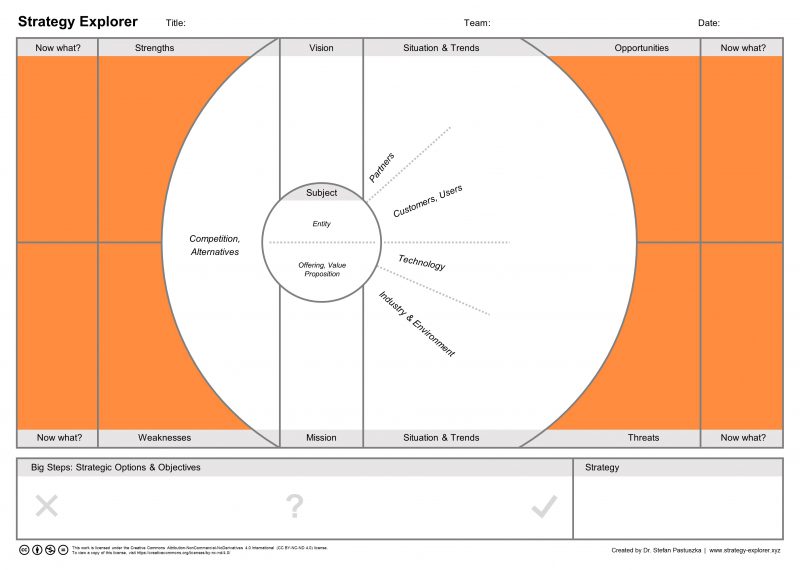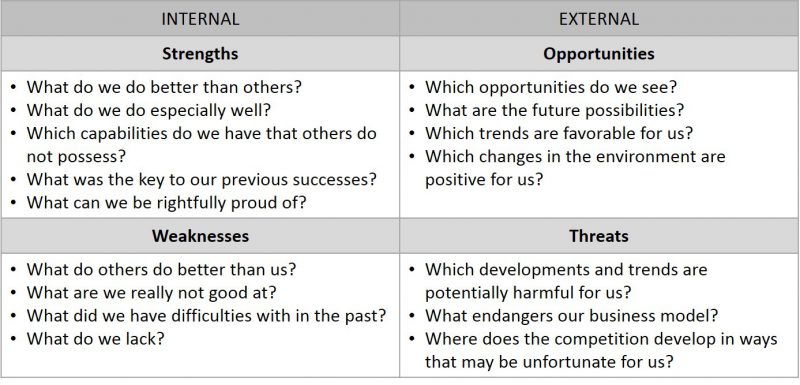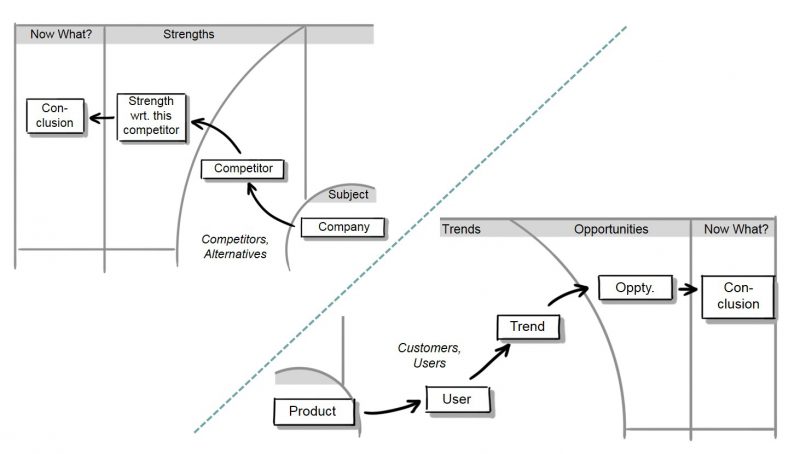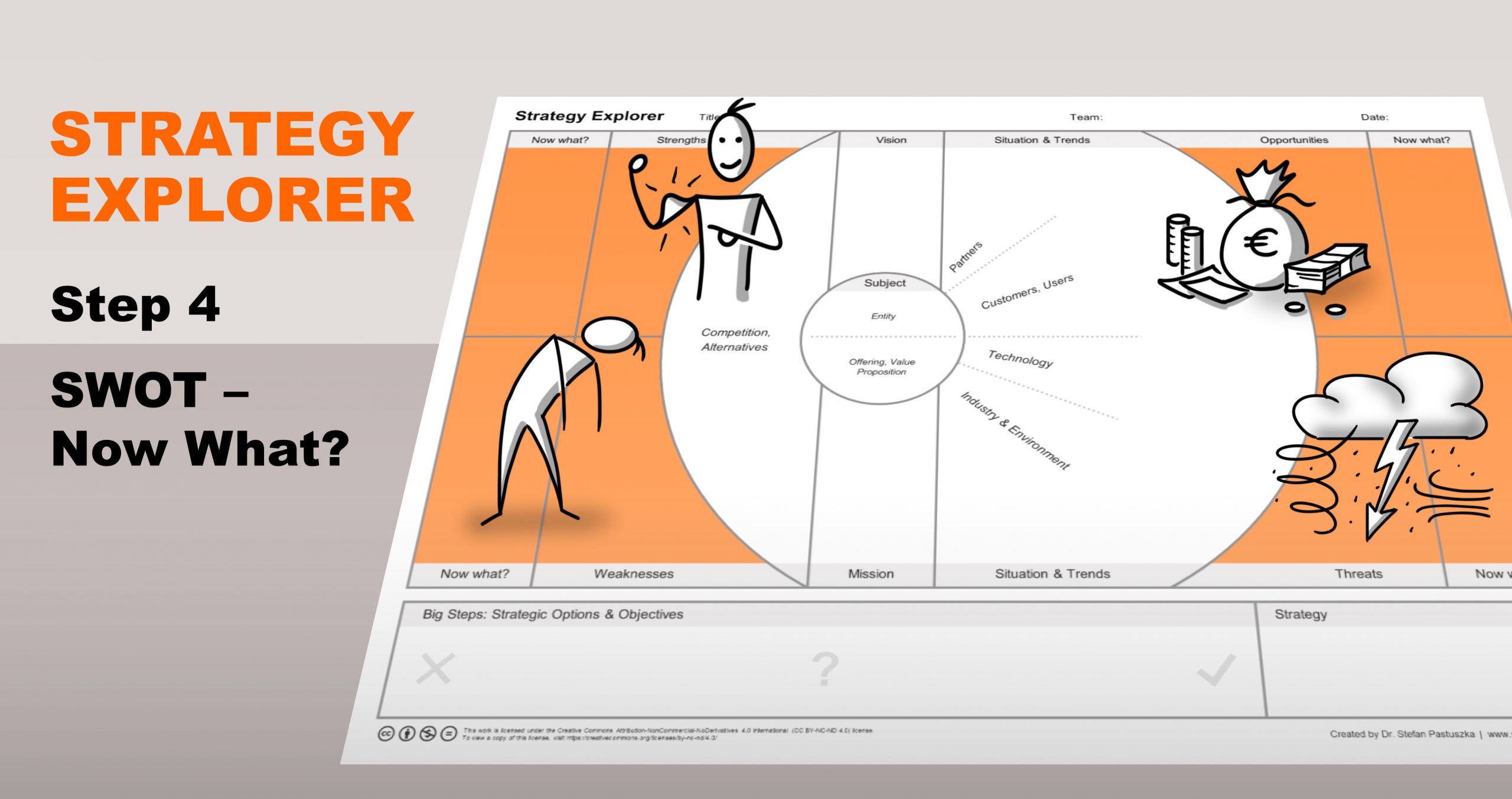Without a clear understanding of the environment we would be in the dark and business success just a question of luck. Therefore, I hope you had many fruitful discussions and inspiring insights in the previous step of analyzing the environment using the Strategy Explorer. However, analysis without conclusions will bring you nowhere. Consequently, it is now time to make sense of your observations and assumptions and to develop the first building blocks to accomplish your vision.
A central tool for this task is the SWOT analysis. It is one of the best known tools in strategy development, the acronym standing for strengths (S), weaknesses (W), opportunities (O) and threats (T). The SWOT analysis is an excellent tool to interpret your observations and structure your thoughts according to the potential implications for your subject matter. It therefore constitutes a core element in the Strategy Explorer method. Here, it is combined with the important step of driving conclusions, the “Now What?” question. Without the latter, the analysis would remain just an analysis.

A meaningful SWOT analysis
Over the years, I have encountered plenty of SWOT analyses exhibiting a grossly different level of quality. How come? The principle of the SWOT is quite simple in general, but there are a few things one needs to consider in order to generate relevant insights. First, let’s have a look at what information belongs into the S, W, O and T fields (formulated for an organization as subject):

Strengths and weaknesses are of internal nature. For example, a poor website or marketing approach is clearly within the own responsibility and could be improved. A comprehensive own patent portfolio would be an excellent asset to build a strong competitive position and could be even reinforced. Strengths and weaknesses lie in the present, they are what we can use or have to deal with today.
In contrast, opportunities and threats are presented through the outside world. They are based on the situation and developments in the environment which can usually not be controlled. For example, a change in regulations might endanger a certain product line or changing end-user behavior might open up a realm of new possibilities. Opportunities and threats typically lie in the (nearer) future.
In practice, SWOT analyses are often conducted without much preparation and without a clear definition of the subject at the center of the analysis, leading to less than optimal results. In order to produce relevant insights, a SWOT analysis should be based on a solid understanding of the environment and a clear agreement on the subject itself (“are we preparing a SWOT for our business unit or for the whole company?”). Having the overall goal present at all times further helps to focus on the observations and findings that will help you to get closer to that goal. Apart from that, a really honest comparison with relevant competitors or alternatives needs to be conducted in order to arrive at the real strengths and weaknesses of the subject. For example, a weakness that all competitors have in common is not a true weakness. Of course, not all strengths and weaknesses have to be fully unique, but they should distinguish the subject from at least the majority of competitors or alternatives.
Typically, the contents in the SWOT fields describe the situation and do not yet contain the activities or measures needed to deal with these situations. This reasoning is the central point in the next step.
Drawing conclusions
For each and every finding of the SWOT analysis, it is important to decide how to deal with it:
- How can the strengths be used and even be improved?
- How can the weaknesses be eliminated or reduced?
- How can the opportunities be best exploited?
- How can the risks be ameliorated?
It is important that every finding in the SWOT analysis corresponds to at least one entry in the “Now what?” field. If you have a finding that does not call for any action, it is probably not a relevant one.
The answers to the “Now what?” question can be of different type, like concrete measures or activities, more general action fields or qualitative goals. Typically, they will range from operative stuff to real strategic options, i.e., large and decisive steps towards your overarching goal. In this part of the process, you should pay attention not to dive too deeply into the operative level of affairs. Try to maintain a certain flight level and focus on the bigger steps that could be undertaken to exploit opportunities, eliminate weaknesses, and so forth. Make sure that you formulate them briefly while being precise enough so that they could be even understood by somebody not present during the process.
Connecting the dots
Clearly, a certain line of reasoning stands behind each of the conclusions in the “Now what?” field. Such logical chains might look like shown in the diagram and connect the subject of your strategy with certain observations that lead to one or more conclusions on which you might decide to act. The Strategy Explorer makes these lines of reasoning visible from start to end.

The major conclusions from the SWOT analysis that are now collected in the “Now what?” fields form the major source of input for the next step in the process: the identification and assessment of strategic options and objectives in the field “Big Steps”.
Stay tuned for the next instalment of this small article series to learn how to come up with a good base of options and big measures that could form the basis of your future strategy. As always, do not hesitate to contact me in case you have questions or comments!

